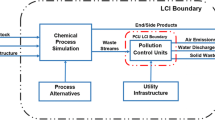Abstract
In recent years, due to severe environmental legislations and extended producer responsibility, leasing has been recommended as a strategy for increasing resources productivity and minimizing waste generation during consumption and product end-of-life (EOL) phase. Hence, it is essential to develop a model that can help leasing company for achieving sustainable production management. In this paper, a model is developed which optimizes the environmental and economical impact of product during leasing and its EOL phase from customers and leasing company point of view. To solve the problem, simulation-based optimization approach is investigated and the integrated mathematical and simulation model is developed for incorporating uncertainty during leasing period. Finally a case study with data from industry is used to validate the approach and potential applications of the developed model are illustrated.
Similar content being viewed by others
References
Fishbein BK, McGarry LS, Dillon PS (2000) Leasing: a step toward producer responsibility. INFORM, New York
Mont OK (2002) Clarifying the concept of product-service system. J Clean Prod 10:237–245. doi:10.1016/S0959-6526(01)00039-7
Robert KH, SchimdtBleek B, deLarderel JA, Basile G, Jansen JL, Kuehr R (2002) Strategic sustainable development—selection, design and synergies of applied tools. J Clean Prod 10:197–214. doi:10.1016/S0959-6526(01)00061-0
Stahel WR (1997) The function economy: cultural and organizational change. In: Richards DJ (ed) The industrial green game, implications for environmental design and management. National Academy Press, Washington
Mont O (2000) Product-service systems. The International Institute of Industrial Environmental Economics. Lund University, Swedish Environmental Protection Agency
Aras N, Güllü R, Yürülmez S (2011) Optimal inventory and pricing policies for remanufacturable leased products. Int J Product Econ 133(1):262–271. doi:10.1016/j.ijpe.2010.01.024
Steers K (2004) Hardware tips: complete PC preventive maintenance guide. http://www.pcworld.com/article/116583/hardware_tips_complete_pc_preventive_maintenance_guide.html. Accessed 1 Aug 2011
Pongpech J, Murthy DNP, Boondiskulchock R (2006) Maintenance strategies for used equipment under lease. J Qual Maint Eng 12(1):52–67. doi:10.1108/13552510610654538
Chien YH (2005) Determining optimal warranty periods from the seller’s perspective and optimal out-of-warranty replacement age from the buyer's perspective. Int J Syst Sci 36:631–637. doi:10.1080/00207720500219054
Erkoyuncu JA, Roy R, Shehab E, Cheruvu K (2011) Understanding service uncertainties in industrial product–service system cost estimation. Int J Adv Manuf Technol 52:1223–1238. doi:10.1007/s00170-010-2767-3
Clark TM (1978) Leasing. McGraw-Hill, London
Mangun DC, Thurston DL (2002) Incorporating component reuse, remanufacture, and recycle into product portfolio design. IEEE Trans Eng Manag 49:479–490. doi:10.1109/TEM.2002.807292
Thurston DL, Delatorre JP (2007) Leasing and extended producer responsibility for personal computer component reuse. Int J Environ Pollut 29:104–126
Zhao Y, Pandey V, Kim H, Thurston D (2010) Varying lifecycle lengths within a product take-back portfolio. J Mech Des 132:1–10. doi:10.1115/1.4002142
Sharma M (2004) Reverse logistics and environmental considerations in equipment leasing and asset management. Dissertation, Georgia Institute of Technology
Kuo T (2011) Simulation of purchase or rental decision-making based on product service system. Int J Adv Manuf Technol 52:1239–1249. doi:10.1007/s00170-010-2768-2
Hanafiah, Chen LY, Narita H, Fujimoto H (2003) Remanufacturing in developing countries concentrated at leasing or selling—a case study of Indonesia. Proceedings Third International Symposium on Environmentally Conscious Design and inverse Manufacturing, Tokyo
Subramanian R, Guptay S, Talbot B (2005) Remanufacturable product design and contracts under extended producer responsibility, working paper
Intlekofer K, Bras B, Ferguson M (2010) Energy implications of product leasing. Environ Sci Technol 44:4409–4415. doi:10.1021/es9036836
Azadivar F (1999) Simulation optimization methodologies. Proceedings of the 1999 Winter Simulation Conference, Arizona
Carson Y, Maria A (1997) Simulation optimization: methods and applications. Proceedings of the 1997 Winter Simulation Conference, Atlanta
Rockwell Automation Technologies, Inc. (2011) http://www.Arenasimulation.com. Accessed 1 Aug 2011
Kleijnen JPC, Wan J (2007) Optimization of simulated systems: OptQuest and alternatives. Simul Model Pract Theory 15:354–362. doi:10.1016/j.simpat.2006.11.001
Jun HB, Cusin M, Kiritsis D, Xirouchakis P (2007) A multi-objective evolutionary algorithm for EOL product recovery optimization: turbocharger case study. Int J Prod Res 45:4573–4594. doi:10.1080/00207540701440071
Itiran (2011) Iran information technology data. http://www.itiran.com/?type=article&id=13822. Accessed 1 Aug 2011
Dell sustainability report fiscal year 2007 in review (2007) http://www.dell.com/downloads/global/corporate/environ/report07.pdf. Accessed 1 Aug 2011
Environmental Vision of Sony (2000) http://www.sony.net/SonyInfo/News/Press_Archive/200010/00-1006E/. Accessed 1 Aug 2011
Choi B-C, Shin H-S, Hur T (2006) Life cycle assessment of a personal computer and its effective recycling rate. Int J Life Cycle Assess 11(2):122–128. doi:10.1065/lca2004.12.196
Iranrahjoo (2011) Service provider for Sony notebook. www.iranrahjoo.com. Accessed 1 Aug 2011
Simapro (2011) Software for environmental assessment. www.pre.nl/simapro. Accessed 1 Aug 2011
Lu LT, Wernick IK, Hsiao TY, Yu YH, Yang YM, Ma HW (2006) Balancing the life cycle impacts of notebook computers: Taiwan’s experience. Resour Conserv Recycl 48:13–25. doi:10.1016/j.resconrec.2005.12.010
Dehghanian F, Mansour S (2009) Designing sustainable recovery network of end-of-life products using genetic algorithm. Resour Conserv Recycl 53:559–570. doi:10.1016/j.resconrec.2009.04.007
Agrawal V, Ferguson M, Thomas V (2009) Is leasing greener than selling? Working Paper, Georgia Institute of Technology College of Management
Author information
Authors and Affiliations
Corresponding author
Rights and permissions
About this article
Cite this article
Shokohyar, S., Mansour, S. & Karimi, B. Simulation-based optimization of ecological leasing: a step toward extended producer responsibility (EPR). Int J Adv Manuf Technol 66, 159–169 (2013). https://doi.org/10.1007/s00170-012-4315-9
Received:
Accepted:
Published:
Issue Date:
DOI: https://doi.org/10.1007/s00170-012-4315-9




